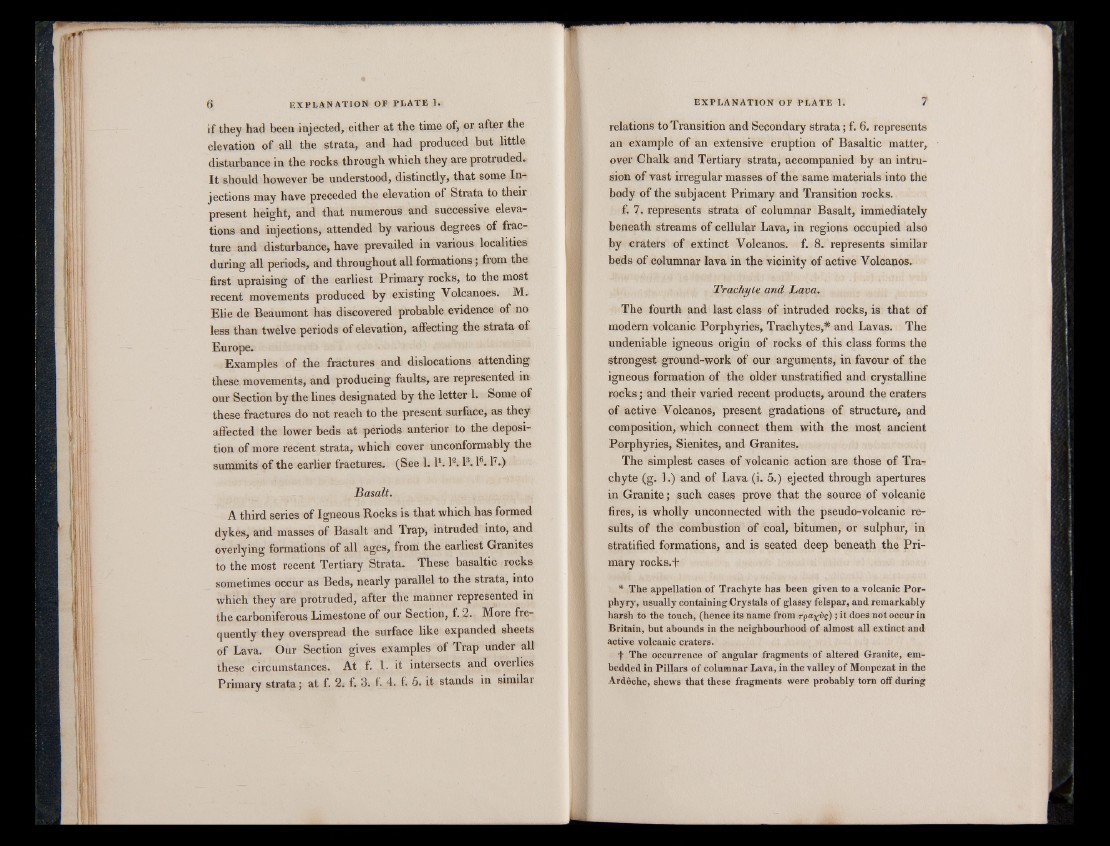
if they had been injected, either at the time of, or after the
elevation of all the strata, and had produced but little
disturbance in the rocks through which they are protruded.
It should however be understood, distinctly, that some Injections
may have preceded the elevation of Strata to their
present height, and that numerous and successive elevations
and injections, attended by various degrees of fracture
and disturbance, have prevailed in various localities
during all periods, and throughout all formations; from the
first upraising of the earliest Primary rocks, to the most
recent movements produced by existing Volcanoes. M.
Elie de Beaumont has discovered probable evidence of no
less than twelve periods of elevation, affecting the strata of
Europe.
Examples of the fractures and dislocations attending
these movements, and producing faults, are represented in
our Section by the lines designated by the letter 1. Some of
these fractures do not reach to the present surface, as they
affected the lower beds at periods anterior to the deposition
of more recent strata, which cover unconformably the
summits of the earlier fractures. (See 1.11.12.13.16* l7-)
Basalt.
A third series of Igneous Rocks is that which has formed
dykes, and masses of Basalt and Trap, intruded into, and
overlying formations of all ages, from the earliest Granites
to the most recent Tertiary Strata. These basaltic rocks
sometimes occur as Beds, nearly parallel to the strata, into
which they are protruded, after the manner represented in
the carboniferous Limestone of our Section, f. 2. More frequently
they overspread the surface like expanded sheets
of Lava. Our Section gives examples of Trap under all
these circumstances. At f. 1. it intersects and overlies
Primary strata; at f. 2. f. 3. f‘. 4. f. 5. it stands in similar
relations to Transition and Secondary strata; f. 6. represents
an example of an extensive eruption of Basaltic matter,
over Chalk and Tertiary strata, accompanied by an intrusion
of vast irregular masses of the same materials into the
body of the subjacent Primary and Transition rocks.
f. 7. represents strata of columnar Basalt, immediately
beneath streams of cellular Lava, in regions occupied also
by craters of extinct Volcanos, f. 8. represents similar
beds of columnar lava in the vicinity of active Volcanos.
Trachyte and Lava.
The fourth and last class of intruded rocks, is that of
modern volcanic Porphyries, Trachytes,* and Lavas. The
undeniable igneous origin of rocks of this class forms the
strongest ground-work of our arguments, in favour of the
igneous formation of the older unstratified and crystalline
rocks ; and their varied recent products, around the craters
of active Volcanos, present gradations of structure, and
composition, which connect them with the most ancient
Porphyries, Sienites, and Granites.
The simplest cases of volcanic action are those of Trachyte
(g. 1.) and of Lava (i. 5.) ejected through apertures
in Granite ; such cases prove that the source of volcanic
fires, is wholly unconnected with the pseudo-volcanic results
of the combustion of coal, bitumen, or sulphur, in
stratified formations, and is seated deep beneath the Primary
rocks.1*
* The appellation of Trachyte has been given to a volcanic Porphyry,
usually containing Crystals of glassy felspar, and remarkably
harsh to the touch, (hence its name from rpa^iç) ; it does not occur in
Britain, but abounds in the neighbourhood of almost all extinct and
active volcanic craters.
f The occurrence of angular fragments of altered Granite, embedded
in Pillars of columnar Lava, jn the valley of Monpezat in the
Ardèche, shews that these fragments were probably torn off during